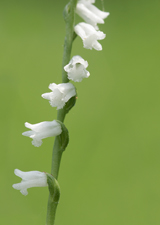Observing Wild Orchids in Florida
The following pages provide some useful information about orchids in general and specifically about how to go about observing Florida's orchids in their natural habitat. Select a page from the dropdown to jump to a specific page or click the Next or Previous links to see all the pages in succession.
Florida, as a state, is home to a number of different ecosystems, spanning a variety of climates from temperate in the north to semi-tropical in the extreme south. Orchids inhabit many of these ecosystems, with the few exceptions being the beach/coastal environments and marine environments. It should also be noted that while a particular ecotype, such as a swamp, may be similar hydrologically in the northern parts vs. the central and southern parts of the state, it will differ climatologically and ecologically due to Florida's diverse climates. Following are few broad environment types in which Florida's orchids may be found:
-
Moist pinelands:

This is a common ecosystem type throughout the state, most often dominated by longleaf pines and wiregrass, along with shortleaf pines, slash pines, and an understory formed by saw palmettos, fetterbush, St. John's Wort, and a variety of other species. In areas where regular fires (either wildfires or controlled burns) keep the underbrush in check, many of our more northern terrestrial species will thrive. The soil is often quite acidic, moist (but not sopping) and often supports mats of sphagnum moss in places.
-
Moist savannahs:

Within the same area as the moist pinelands are places where fire, hurricanes, or other natural "disasters" have cleared swaths of trees. Because the water table is so high and there is no transpiration from the trees to keep water levels in check, the water ends up preventing recolonization from the trees. Other moisture-loving shrubs will tend to recolonize and eventually choke out lower-lying vegetation such as the orchids, so active management with fire is crucial to maintaining these areas for orchids, carnivorous plants, and the like to thrive.
-
Wet roadsides/ditches:

The state of Florids is criss-crossed by a large network of roads, from the high-speed interstates and turnpikes to the dirt-paved forest roads that allow access to wild lands throughout the state. When roadside vegetation is kept at manageable levels, and moisture is added, this creates a prime habitat for many of the species found in the two ecosystems listed above. The key to managing these areas is the implementation of eco-friendly roadside mowing practices that allow wildflowers to grow during the spring, summer, and fall, with a good mowdown during the wintertime. And while it is certainly necessary to keep a more close-cropped margin for vehicles to stop without being in waist-tall grasses, far too often the roadsides are cut down and sprayed with herbicides all the way to their visible edges to maintain a uniform, green, lawn-like appearance. This, quite frankly, is boring and dull--it certainly does not present Florida, the Land of Flowers, in a good light. In areas where wildflowers are allowed to grow, the roadsides become a wonderful series of colors that breaks up the monotony of those long drives.
-
Mixed Woodlands:

While many of Florida's lands are wooded and would certainly fall in the category of "woodlands", woodlands in this definition would consist of somewhat drier areas where the soil is moistened by seasonal rains, but not kept moist consistently by the presence of standing or running water. These might include embankments starting a few feet above a swampy area, stream, river or lake, but also include areas on higher hills and ridges well above any bodies of water. The forest itself would be a mix of hardwoods and softwoods (such as pines or junipers) with an understory kept in check by relatively low light levels reaching the ground.
-
Upper/Dry Pinelands:

In areas where the ground is significantly elevated above the water table, more dry pinelands (with occasional scrub live oaks and other hardwoods) dominate. The soil is typically sandy/peaty and well-drained. The ubiquitous saw palmettos and other scrub form the understory of these areas. Only a handful of our wild orchids hail from this ecotype, as our native orchids, on the whole, tend to be a more moisture-loving group.
-
Fields/Ruderal areas:

In more dry, open, grassy areas at the margins of drier woodlands, but more often kept this way due to human activity, several orchid species thrive.
-
Coastal scrub:

One, or perhaps several, orchid species can be found growing in the coastal scrub dominated by sand pines, saw palmettos, and coastal rosemary.
-
Swamps/hardwood hammocks

The swamps and hammocks are probably the most significant habitat for orchid species within our state. In the northern parts of our state, many northern species find refuge from our intense summer heat in the cool of the swamps. In the southern swamps, this is just the opposite, where the warmth of the nearby water mitigates the effects of our cold winters (at least cold compared to the tropical climes where many of these species originated). The vast majority of our orchid species, found in the southern tip of our state, favor the swamps and hammocks, often growing as epiphytes in the trees or semi-epiphytes on the stumps of trees and even rotting, floating logs.
There are many areas in Florida where these types of ecosystems can be found. Parks (county, regional, state, and national); state forests; national forests; river, lake and swamp margins; and many roadsides going through natural areas are great places to observe our wild orchids. The next few pages break down Florida by region and indicate which species can be found in those areas.
Copyright © 2010 Prem Subrahmanyam, All Rights Reserved.
No Text or Images from this web site may be used, in whole or in part, without the express permission of the author.
For further information, see the Terms of Use page.


